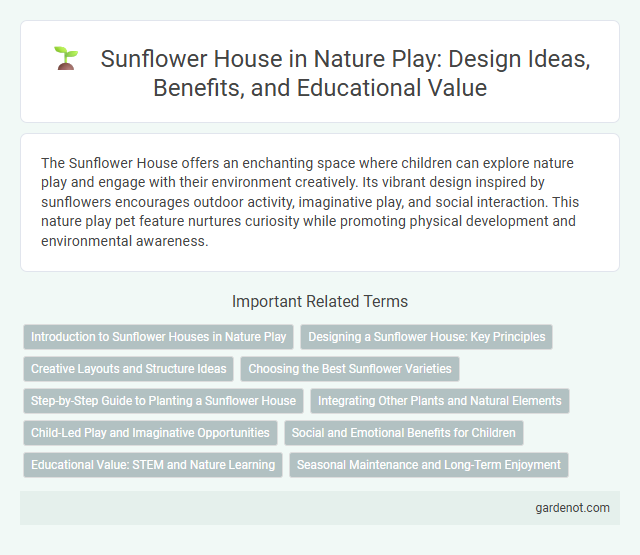The Sunflower House offers an enchanting space where children can explore nature play and engage with their environment creatively. Its vibrant design inspired by sunflowers encourages outdoor activity, imaginative play, and social interaction. This nature play pet feature nurtures curiosity while promoting physical development and environmental awareness.
Introduction to Sunflower Houses in Nature Play
Sunflower houses in nature play create immersive, living structures formed from sunflowers that children can enter and explore, encouraging hands-on interaction with nature. These vibrant, towering plants provide sensory stimulation through color, texture, and scent, fostering creativity and environmental awareness. Integrating sunflower houses into outdoor learning spaces supports physical activity, imaginative play, and connection to plant life cycles.
Designing a Sunflower House: Key Principles
Designing a Sunflower House involves maximizing natural light and promoting a connection to nature through abundant sunflower motifs and organic shapes. Incorporating sustainable materials and eco-friendly practices supports environmental harmony and durability. Key principles include creating open, inviting spaces that inspire creativity and encourage outdoor play.
Creative Layouts and Structure Ideas
Sunflower House features innovative nature play designs that incorporate organic shapes and natural materials to stimulate children's creativity and exploration. Its creative layouts blend open spaces with intimate nooks, encouraging imaginative play and social interaction. The structure integrates climbing elements, sensory gardens, and interactive installations that enhance cognitive development and physical activity.
Choosing the Best Sunflower Varieties
Selecting the best sunflower varieties for a nature play environment depends on factors such as height, bloom time, and resilience. Tall varieties like 'Mammoth' provide towering visual interest and seeds for wildlife, while dwarf types such as 'Teddy Bear' fit smaller spaces and offer dense, fluffy blooms. Choosing disease-resistant and fast-growing sunflowers ensures sustained playtime engagement and vibrant seasonal color.
Step-by-Step Guide to Planting a Sunflower House
Planting a sunflower house begins with selecting tall, fast-growing sunflower varieties such as Mammoth or Russian Giant, ensuring they reach heights over 8 feet to form a natural structure. Prepare soil rich in organic matter, plant seeds 1 inch deep in a circular pattern about 6 inches apart, and water consistently to promote healthy growth. Maintain the sunflower house by providing support with stakes if necessary and pruning to keep the interior accessible and inviting for children's nature play.
Integrating Other Plants and Natural Elements
Sunflower House incorporates a diverse range of native plants and natural elements to create an immersive nature play environment that encourages sensory exploration and environmental awareness. Integrating flowering plants, grasses, and textured wood materials fosters a rich habitat for local wildlife, enhancing ecological learning opportunities for children. Natural features such as stone clusters and water elements support imaginative play while promoting a deeper connection with the outdoors.
Child-Led Play and Imaginative Opportunities
Sunflower House fosters child-led play by creating a vibrant, nature-inspired environment that encourages exploration and creativity. Its design incorporates natural materials and open-ended elements, offering endless imaginative opportunities for children to invent stories and games. The space nurtures autonomy and curiosity, promoting developmental growth through self-directed, meaningful play experiences.
Social and Emotional Benefits for Children
Sunflower House nature play areas boost children's social skills by encouraging cooperative play and communication in an outdoor setting. Engaging with natural elements helps reduce stress and fosters emotional resilience, enhancing overall mental well-being. These environments promote empathy and self-regulation, essential for healthy emotional development in early childhood.
Educational Value: STEM and Nature Learning
Sunflower House offers immersive STEM and nature learning experiences by integrating hands-on activities that teach plant biology, environmental science, and ecological systems. Children explore concepts such as photosynthesis, pollination, and habitat interdependence through interactive play, fostering critical thinking and observation skills. The design encourages curiosity about natural processes, supporting educational outcomes in science, technology, engineering, and math within an outdoor setting.
Seasonal Maintenance and Long-Term Enjoyment
Seasonal maintenance of the Sunflower House includes regular inspections for structural integrity, cleaning surfaces to prevent mold and mildew, and treating wood components with weather-resistant sealants to ensure durability. Proper upkeep during changing seasons safeguards the playhouse from damage caused by moisture, UV rays, and temperature fluctuations, enhancing safety and aesthetics. Consistent care extends the lifespan of the Sunflower House, providing children with a secure and enjoyable nature play experience year-round.
Sunflower house Infographic

 gardenot.com
gardenot.com